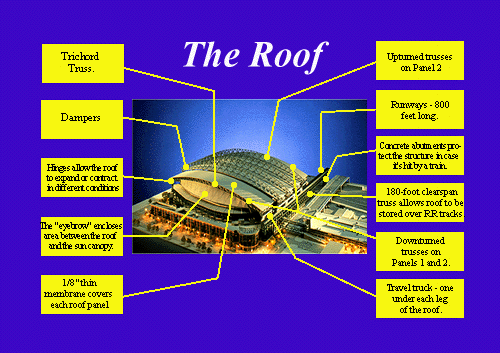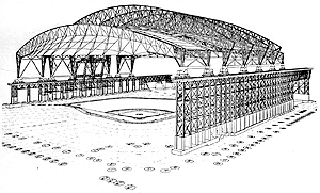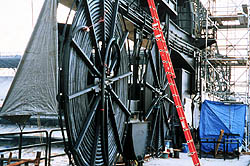|
Subscribe / Renew |
|
|
Contact Us |
|
| ► Subscribe to our Free Weekly Newsletter | |
| home | Welcome, sign in or click here to subscribe. | login |
Safeco Field
|
|
Stats class: The stadium roof
Roof facts
Weight: Three roof panels weigh 11,000 tons and contain enough steel to build a 55-story skyscraper. Height: 275 feet from ground level to the highest roof truss, the same height as the Kingdome. Inside, the roof is 217 feet above the field at second base. Span: 631 feet for panels one and three. Panel 2 is 655 feet (the Aurora Bridge's center span is 800 feet) Materials: the roof is built of steel fabricated in Belgium. Imagine a sandwich with three-inch thick corrugated steel on the bottom, a 5/8th-inch thick gypsum/glass fiber reinforced board for sound absorption in the middle and a 1/8th-inch thick waterproof, polyvinyl chloride skin. Load capacity: The roof is designed to withstand snow drifts of 80-90 pounds per square foot, as much as seven feet of drifted snow. Wind capacity: The roof is designed to withstand sustained winds of 70 miles per hour, and open and close in winds up to 30 miles per hour. Number of structural pieces: 12,800 Length of runway: 800 feet Height of runway: south runway 100 feet, north runway 50 feet Total weight of structural steel in runway: 2,500 tons Total steel tonnage: 10,800 tons Opening and closing time: At top speed the roof can move six inches per second. Its slow speed is 32 inches a minute. Opening and closing will depend on wind, weather and other factors but will average 10-20 minutes. Maximum panel travel distance: 500 feet for panel 1 Appearance was a major design consideration for the roof. After much consideration of different concepts the team chose to go with a raw, industrial look which kept the structure and working parts exposed. This was less costly and links the stadium visually with its industrial neighborhood.
Trichord trusses were used for stability during erection. This design allowed crews to build each truss on a platform located outside the bowl so the stadium and roof construction could proceed independently. The roof's triangular downturned legs were designed to mirror the trichord trusses. The shape of the trusses was largely determined by the trajectory of baseballs. The center panel is the highest at 217 feet high, making it unlikely that it will ever be hit by a ball. The side panels were designed so they will not interfere with the path of a fair ball.
The ``eyebrow'' is a tension-supported structure, with a series of cables tying it back to the main structure. The eyebrow provides a transition from the roof panels to the stadium's sun canopy. The roof's cable reels are like giant extension cords, providing power to drive the roof. The cable unrolls as the roof moves along the runway. Mechanism: The roof moves on motorized steel wheel assemblies which travel on steel rails. The roof panels sit on long legs, eight to a side, which are fastened to wheel assemblies or ``trucks'' which each have 8 steel wheels. The trucks are powered by 96 10-horsepower motors which run on DC current. The average load per wheel is 180,000 pounds. Normally it will take five to 10 seconds to stop the roof movement but an emergency stop button will halt the roof in three seconds.
 djc home | top | special issues index
|





